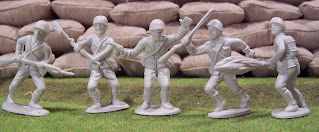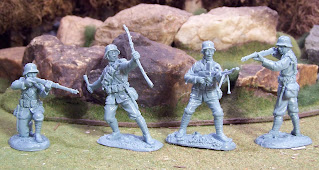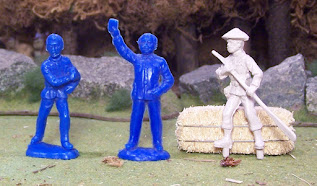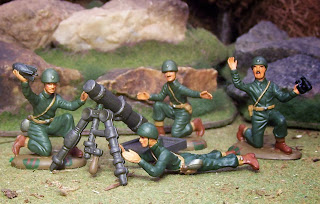The Italian Army has received much criticism regarding its performance during WWII, mainly because Germany had to come to their rescue in the Balkans and North Africa. Their collapse outside Stalingrad did not help their reputation either. But when you consider Italy's availability of raw materials, industrial output, technological development, and overall military strength at the outset of the war, you realize that they were utterly underprepared to fight in WWII, and the soldiers' morale reflected that. It is also hard to believe that under such conditions the Italian leadership committed them to fight on so many fronts: Southern France, West Africa, East Africa, the Balkans, and later on Russia. They were certainly courting disaster. Of course, there were many displays of courage at the individual and small unit level, and even at the divisional level as was the case of the Folgore Division, an elite paratroop unit which fought in North Africa for 2 years, and that during the Second Battle of el Alamein, held up against the combined attacks of 4 Commonwealth Divisions. After the armistice of September 1943, the Italian military was divided in two. Those continuing to fight on the side of the Axis, and those fighting with the Allies, including those fighting guerrilla operations on the northern part of Italy, still controlled by the Germans. During the war 4 million men served in the Italian Army, of which half a million died, so in terms of human cost, they certainly paid their fair share. As far as figure availability goes, we have a few sets available, most of them produced in the last few years.

Airfix Italian Infantry
For the last 3 decades these had been among the very few Italian Infantry figures. The only other ones that I am aware of from that time are the Atlantic guys. A fairly decent set. Not the most active poses, but with nice, detailed sculpting. I bought these second hand, so the paint job is not what I would like it to be. I think that once they are repainted they will look quite a bit better.
Classic Toy Soldiers Italian Infantry
CTS released this about 5 years back. They display a bit more intensity than the Airfix guys, however the sculpting is a bit less detailed. Still a welcome addition after so many years of waiting. These guys could be fighting in the Balkans or in the Soviet Union.
Waterloo 1815 El Alamein Division
Waterloo 1815, mainly a producer of 1/72 figures came up with this set around the same time as CTS. There were multiple Italian Divisions -Pavia, Trieste, Trento, Ariete, Brescia, Littorio, Bologna-, which fought during the First and Second battles at El Alamein, and the fighting in between. One of these guys appears to wear a Bersaglieri helmet, but there were Bersaglieri units attached to several divisions, so it does not really help to narrow down which one they belong to. In any case, they are good troops to have next to the DAK to fight the British 8th Army.
Waterloo 1815 Folgore Division
Another good set for the West Desert campaign. They could fight side by side with the guys above. I like how they reflect the relaxed dress code that existed in the North African desert. The only thing I don't quite like about these guys are their bases, which make them a bit wobbly.
21st Century Toys Italian Infantry
A very nice set from 21C toys. The poses, the detail, even the paint job. Very nice. Their uniforms seem a bit darker than the real ones though. I'll probably struggle deciding whether to paint the other guys trying to match these or trying to reflect the original colors.
DGN Italian Infantry - Part I
This is a welcome addition to the scarce WWII Italian figures available up to date. The prone guy has a strong resemblance with the Airfix guy. The others seem to be originals. The mortar guy is a bit hard to stand as it keeps falling over.
DGN Italian Infantry - Part II
The officer in this set clearly resembles the Airfix officer. The other guys also appear to be originals. The head dress that they wear matches that of the Waterloo 1815 El Alamein Division. The weakest figure here is the prone machine gunner. His left arm is too short and he does not rest on the ground entirely.
DGN Italian Infantry - Part III
The rest of the set. Not much to criticize here. These guys appear to be Bersaglieri, based on the plume that they have on the left side of their helmets.
Atlantic Italian Infantry
These are Italian assault infantry troops I had to admit that I had to think twice about buying them. Some of the poses are a bit unreal -like the guy on the left- and I am not all that excited about them, but in the interest of having a complete collection I went ahead and got them. The best figure in the lot is probably the guy kneeling with the binoculars. Note also that the 10 figure set only has 6 unique poses.
Atlantic Italian Bersaglieri - Part 1
These are 60 mm figures. A very nice set from Atlantic. Good, dynamic poses, and a good variety of weapons. I doubt they came painted out of the factory. In any case, they seem to be ready for a second coat.
Atlantic Italian Bersaglieri - Part 2
A mortar man and a motorcycle. Definitely a very nice set. These guys seem a bit overdressed for the desert, so most likely I'll have to use them in European scenes. By the way, there is also a 54mm set of traditional Italian Infantry made by Atlantic which I am not showing here, but I hope to get at some point.
Dulcop WWI Italian Troops
Dulcop really gave us a sampler of troops here. We are looking at two Bersaglieri (second and the sixth from the left), two Arditii, a specialty of Italian Army which assaulted the trenches with hand grenades and long knives (first and fifth) and two Alpini (the two in the middle). While these guys are technically WWI troops, considering that Italy did not modernize their military that much during the interwar period, I think that their uniforms and weaponry could pass as WWII equipment. A nice, dynamic set by Dulcop, even if some of the poses seem a bit off balance. The officer's heard is also a bit too small. However the head gear and the facial hair in some of the figures are quite unique. A good addition to the collection.
Waterloo 1815 WWI Italian Infantry - Part I
From the bushy set of feathers on their helmet, this is a set of what appear to be Bersaglieri troops. While they are also WWI figures, as we've pointed out already, the Italian uniform and equipment did not change much in the inter-war years, so I think these guys will blend in well with their WWII peers. In terms of the set itself, I like the poses and detail on most of the figures. The only one that is a bit odd is the man throwing the grenade. It's not very apparent on this picture, but his front leg is too close to his back leg; not quite the way one would throw an object.
Waterloo 1815 WWI Italian Infantry - Part II
A nice set of poses here. I like the man on the left, crouching, but not quite kneeling. There is not much to criticize. Perhaps the only other thing to point out is that they are made out of this very light but hard plastic, which makes it a bit annoying to take off the spruce. You need a sharp knife, and you need to apply a good bit of pressure too, so if you slip a bit you might be slicing off your finger. One good thing is that Waterloo chose to give them a regular base. An improvement over those funny bases in their WWII sets.
Atlantic Italian Alpine Troops - Part I
This is another set that is a bit hard to come by. What makes it special is that it has quite a few unique items in it. For instance, on the left you can see that it has what looks like a snowmobile. I don't really know if these were around at the time of WWII, so perhaps these guys represent post WWII figures. As you can see, it also comes with a small howitzer, but there don't seem to be any figures to operate it. And then there is the skier. This is perhaps my favorite pose in the set.
Atlantic Italian Alpine Troops - Part II
Here is a view from behind of the same three items. As you can see, there is a second man sitting on the snowmobile firing on the move. The tricky thing though is that he does not like to stay on his seat and there is nothing to keep him there, so if you move the snowmobile, you constantly need to reposition him.
Atlantic Italian Alpine Troops - Part III
These are the rest of the figures. The man on the right is the only 'traditional' pose. The other two are again, quite specific to the Alpine genre. There is the man sitting on the sled, which is a bit too relaxed, if you ask me, and then there is the man leading the pack mule. So all in all a nice set, but I feel that you need to combine them with some other figures to have a real fighting unit. Even combining them with more Atlantic Alpine Troop sets would not be good enough, as you need to have a few more of the traditional poses.
Atlantic Italian Heavy Weapons Team - Part I
This set might actually be representing post WWII figures, but I think they can still pass for WWII guys. As you can see, there are 4 figures. The three kneeling guys are the mortar crew. The prone guy is supposed to be manning a heavy machine gun, but it was missing from the set when I got it. As it's the case with all other Atlantic figures, they come unpainted. These were painted by their previous owner, who actually did quite a nice job. All in all a good set.
Atlantic Italian Heavy Weapons Team - Part II
So I managed to find the machine gun that goes with the prone guy. And one more kneeling guy, which looks like he might be supporting the machine gunner, or at least that's how I plan to use him. In terms of the machine gun, I think they took the 'heavy weapons' thing quite seriously as this looks more like an anti-tank gun based on size.
BUM Infantry - Part I
This is machine gun team is sold as American by BUM. The art on the box shows them wearing GI uniforms, however when you look at the actual figures I don't really recognize the features of the American uniforms. So I actually plan on using them as Italian Infantry, since they could use a bit of help when it comes to heavy weapons and the helmets and uniforms are more similar to the Italian one. The poses are actually OK, but the level of detail on the figures, is not so great. For instance, the face of the man on the left is pretty plain.
BUM Infantry - Part II
Another heavy weapons team from BUM. Also allegedly American, but note really. This set also comes with the barbed wire, but I did not include it in the picture to get a better shot. Note also that the figures seem to be clones. You can tell not only because the level of detail is a bit faded, but also because the original oval bases are now encased in larger rectangular bases.


































































